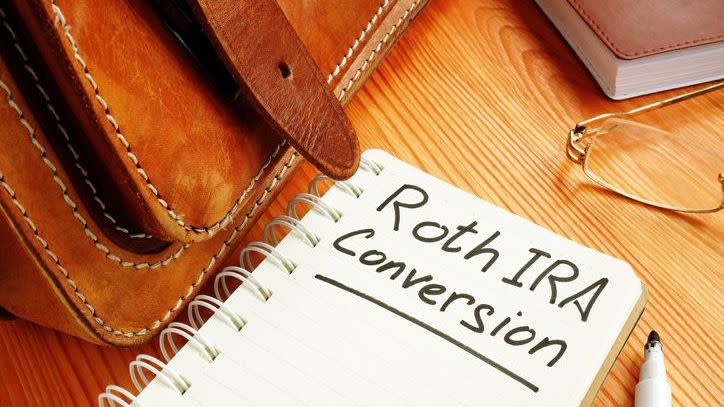If you’re 60 years old and have $1.2 million saved for retirement in a traditional IRA, you may be starting to think about required minimum distributions (RMDs) and the hefty annual tax bill they can bring once you turn 73. Converting to a Roth IRA each year can help you reduce or avoid RMDs and get your tax bill under control, but it also comes at a cost. Discuss your Roth IRA conversion questions with a financial advisor to determine if this strategy fits with your broader financial plan.
RMD rules: the basics
Once you turn 73, the IRS requires you to begin taking annual distributions, called required minimum distributions (RMDs), from traditional IRAs, 401(k)s and similar tax-deferred accounts. RMDs are calculated by dividing your account balance by your life expectancy factor, a value determined by the IRS based on your age.
RMD withdrawals are treated as ordinary income. With a large IRA balance, the size of required RMDs could easily push someone into a higher tax bracket and result in a higher tax bill. Remember that a financial advisor can be a valuable resource when it comes to planning RMDs.
Roth Conversions


Roth IRAs, unlike traditional IRAs and 401(k)s, are not subject to RMD rules. So by converting your IRA to a Roth, you can avoid paying additional income taxes on mandatory IRA withdrawals in retirement. The problem is that you have to pay income tax on the amount you convert at your ordinary income rate when you convert it. This could lead to a huge tax bill if you were to convert a $1.2 million IRA into a Roth at once.
Instead, gradually converting your traditional IRA to a Roth IRA allows you to control when you pay taxes. Instead of unspecified mandatory RMD withdrawals, you choose when to make taxable Roth conversions. Roth withdrawals in retirement are then tax-free, provided you wait five years to withdraw those assets.
Please note that the five-year period applies to any conversion. If you were to convert part of your IRA in 2024, 2025, and 2026, you would have to wait until 2029, 2030, and 2031, respectively, before you could withdraw each group of funds tax-free.
If you need extra help navigating the rules surrounding Roth conversions, use this tool to match with a financial advisor.
A Roth conversion example
Assuming your investments grow 5% each year for 13 years, your $1.2 million IRA could be worth about $2.3 million by the time you reach age 73. By then, your first RMD would be about $87,000, based on the IRS life expectancy factor. Assuming you receive $80,000 in taxable income annually from pensions and Social Security, adding $87,000 would push you from the 22% bracket to the 24% bracket. (This assumes that current tax brackets remain in effect after 2025, when key provisions of the Tax Cut and Jobs Act expire.)
But with 13 years of $120,000 Roth conversions already completed, the IRA balance requiring RMDs could be reduced to about $42,000 at age 73. Your first RMD would be just under $1,600. This probably wouldn’t push you into a higher bracket and will save you thousands in annual taxes during retirement, compared to taking the full $87,000 distribution without prior Roth conversions.
The key is not to immediately convert your entire IRA to a Roth, but rather to take a step-by-step approach. By limiting Roth conversions to a certain amount, you can control and potentially reduce your tax liability. By spreading the conversions over time, taxpayers can top up their current bracket without exceeding it. Staying in the lower brackets protects more money from future taxes than paying the IRS immediately at current rates.
But you don’t have to do it all alone. A financial advisor can help you plan your Roth conversion strategy and manage your taxes in retirement.
Roth Conversion Restrictions


However you do it, Roth conversions involve taxes. Without sufficient non-retirement savings or other sources of income, investors may struggle to pay conversion taxes or be forced to sell investments at a loss. Optimal timing and tax planning are also a challenge. Tax rates and laws can change frequently, making it difficult to predict tax rates decades in advance. Income fluctuations due to bonuses, dividends or retirement plan withdrawals also complicate the projections.
Converting too little undermines the goal of avoiding higher future RMD taxes. But if you convert too much, you could end up in a higher bracket now or reduce your flexibility as tax rates drop. Balancing current and future tax minimization is difficult because there are many uncertainties over the long term.
Additional factors may also play a role. Deductions that reduce taxable income, state taxes, fluctuating investment returns, and income from other sources such as part-time work are all potentially important variables to consider to determine the optimal Roth conversion strategy. If you need additional help navigating these factors, consider working with a financial advisor.
In short
Roth IRA conversions allow investors to take control of the timing of their tax liability. Paying taxes now at known rates through incremental conversions can reduce total lifetime taxes compared to unpredictable mandatory RMD withdrawals decades into the future. But Roth conversions today come at a cost, require non-pension funds to pay taxes, and require significant analysis and some guesswork to optimize.
Retirement planning tips
-
A financial advisor can help develop Roth IRA conversion strategies. Finding a financial advisor does not have to be difficult. SmartAsset’s free tool matches you with up to three vetted financial advisors serving your area, and you can have a free introductory meeting with your advisors to decide which one you think is right for you. If you’re ready to find an advisor who can help you achieve your financial goals, get started now.
-
Knowing how much money you need to retire and whether you’re on track to reach that goal is critical as you plan for your golden years. SmartAsset’s retirement calculator can help you estimate how much you may have in savings when it’s time to retire.
-
Have an emergency fund on hand in case you encounter unexpected expenses. An emergency fund should be liquid – in an account that is not at risk of significant fluctuations like the stock market. The trade-off is that the value of liquid cash can be eroded by inflation. But with a high-interest account, you can earn compound interest. Compare savings accounts from these banks.
Photo credits: ©iStock.com/monkeybusinessimages, ©iStock.com/designer491, ©iStock.com/designer491
The post I’m 60 with $1.2 Million in an IRA. Should I Convert $120,000 Per Year to a Roth to Avoid RMDs? first appeared on SmartReads by SmartAsset.







